The Ultimate Guide to Hiking Essentials
It's a good habit to have the "Ten Essentials" with you every time you go into the backcountry, even on day walks. That is accurate; you may only use a handful or none on a typical vacation. When something goes wrong, you'll realize the importance of having these hiking essentials in an emergency.
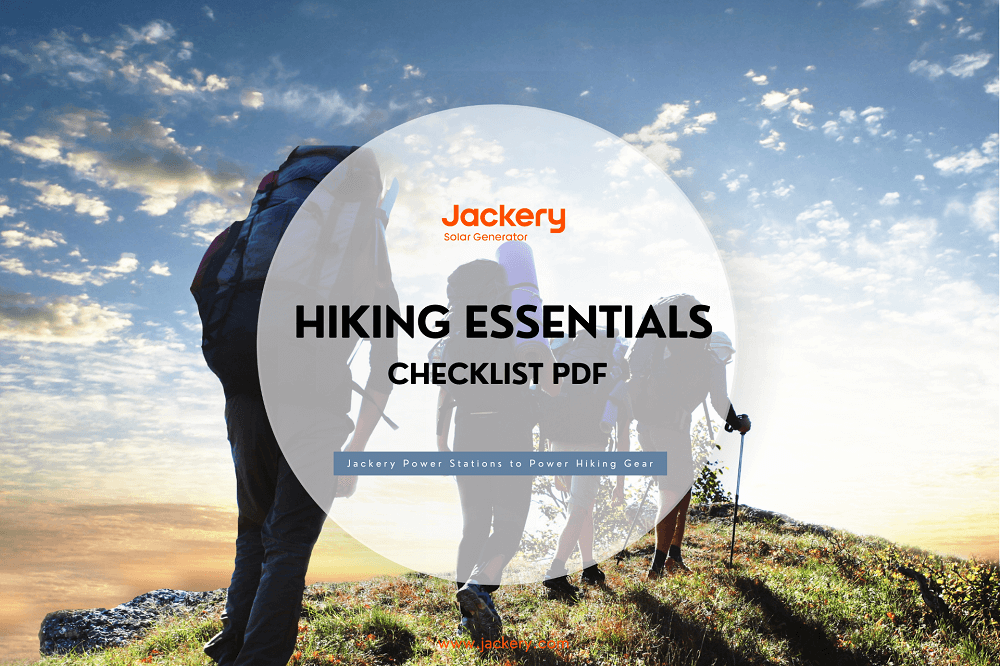
The Mountaineers, a Seattle-based group for climbers and outdoor adventurers, compiled the first Ten Essentials list in the 1930s to help people be prepared for emergency circumstances in the outdoors. A map, headlamp/flashlight, compass, sun protection, additional clothing, first-aid supplies, a fire starter, a knife, and extra food were all on the list back then.
This comprehensive hiking essentials guide covers all you need to know about ten essentials, clothing gear, dog hiking gear, and more. We highly recommend Jackery Explorer power stations for your hiking power needs, which provide ultra-fast charging and incredibly high efficiency. The Explorer 300, with a capacity of 293Wh, is perfect for both day and long-term hiking.
|
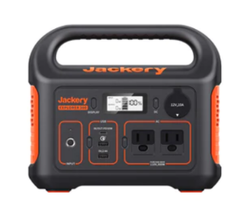 |
|
|
- 293Wh Capacity, 300W Inverter, 500W Surge - Quick AC charging in just 2.5 hours - Supports six smart devices at once - Excellent BMS protection - 36.4dB quiet power station |
How to Use Hiking Essentials Checklist
Use this helpful hiking essentials checklist to ensure you have everything before leaving. The following are suggestions for making the most out of the lists:
- The 10 Essentials: Whether you're hearing about the ten essentials for the first time or have been toting them around for years, the beginning of a season is an ideal time to review your supplies and brush up on your skills.
- Checklist Guideline: You can modify the goods you bring for your specific trip based on variables like expected weather, level of difficulty, expected duration, and proximity to medical care. This guideline is detailed on purpose, but it may need to be more balanced for your purposes. Change them up to fit your hike if you must.
- Printable Checklist PDF: The PDF versions of the checklists can be printed out and used as a handy packing guide. Those who like a more traditional checklist experience may want to laminate their forms. Then, make notes on them with a dry-erase pen.
10 Hiking Essentials
The American Hiking Society recommended that everyone pack the "Ten Essentials" for every hike. Pack these goods whether you intend to be gone for a few hours or several months. Learn how to utilize and become acquainted with these items.
It's time to gear up after checking the weather and getting excited to start the path. The only question is, what gear for hiking should you pack to ensure your safety and comfort?
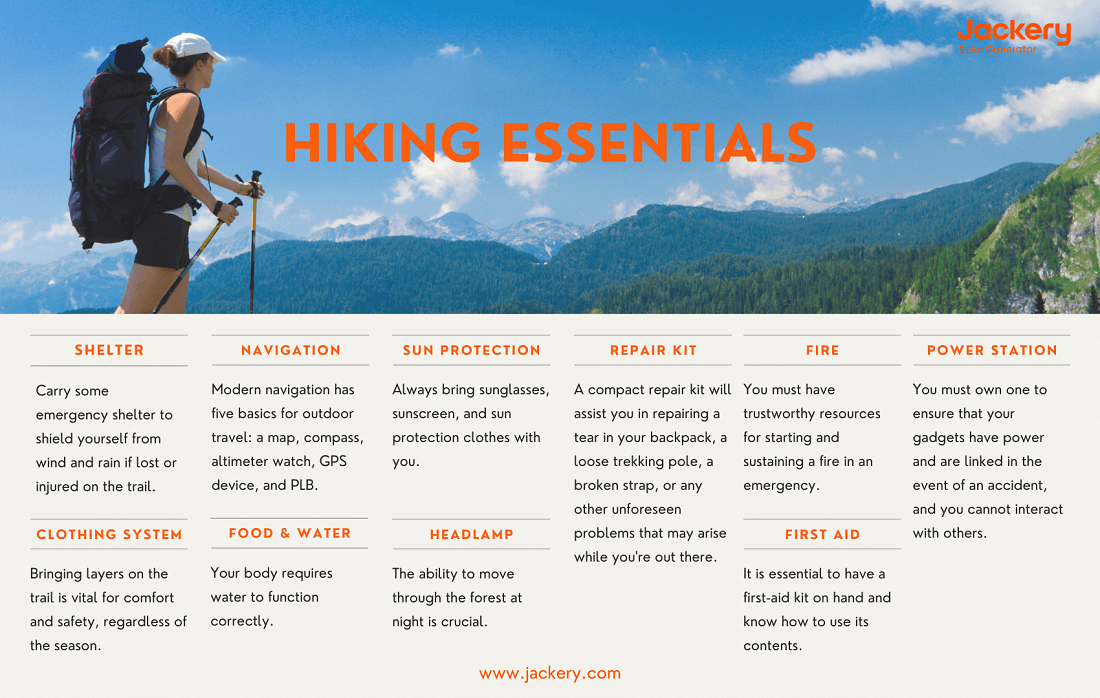
If you've ever pondered about this, you're not alone. It's a good idea to pack hiking essentials, like a shelter, map, headlamp, sunscreen, repair kit, food, water, clothes, first aid supplies, and a fire starter.
Shelter
Carry some emergency shelter to shield yourself from wind and rain if lost or injured on the trail. Weather conditions can change quickly, especially in mountainous areas, and temperatures drop considerably at night. In general, lightweight insulating goods for shelter should be packed as part of your hiking and camping needs. It is critical to recognize that your tent serves only as an emergency shelter if you continually keep it with you.
When people become lost on a route and need to spend the night outside, one of the biggest reasons they perish is a lack of shelter. Hypothermia can develop after prolonged exposure to cold conditions like wind, rain, or water. Some of the most excellent places to stay include:
- Ultralight Tarp
- Bivy Sack
- Emergency Blanket
Navigation
Modern navigation equipment comprises five basics for outdoor travel: a map, compass, altimeter watch, GPS device, and personal locator beacon (PLB).
You still need hiking navigation, even if you have a great sense of direction. The best and most reliable method of navigation is using a paper map. You can get one at the trailhead or, on special occasions, at the tourist center. You should also take pictures of any trail maps you find at the beginning of your hike.
Physical maps are the most trustworthy, but digital maps are more convenient. We strongly advise you to have a number of these downloaded on your phone, at least one of which you can use offline in case you lose service on your climb.
- Paper & Digital Map
- Compass
- Altimeter Watch
- GPS Devices
Clothing System
The clothing you wear is some of the most critical hiking essentials! Bringing layers on the trail is vital for comfort and safety, regardless of the season.
Cotton should be avoided in cold situations since wet cotton does not provide insulation, is challenging to dry, and can make you harder. Cotton traps heat in the heat, which isn't great, either.
Pack a fleece or insulated jacket if there's a chance it'll be cold out or if you'll be out longer than you expect. It can be surprisingly hard on summits or in the shade when you stop for a break, and the temperature difference between mid-day and morning and evening temps can be significant.
- Base Layers
- Mid Layers
- Outer Layers
- Hiking Boots
Sun Protection
Always bring sunglasses, sunscreen, and sun protection clothes with you. Failure to do so can cause sunburn and snow blindness in the short term, as well as accelerated skin aging, skin cancer, and cataracts in the long run.
In the outdoors, quality sunglasses protect your eyes from potentially harmful radiation. Extra-dark glacier glasses are required for extended travel on snow or ice.
Long periods spent outside might expose you to UV rays, which cause sunburn, premature skin aging, and skin cancer. Wearing sunscreen is advised to help decrease your UV exposure.
- Sunglasses
- Suncream
- Sun-Protection Clothing
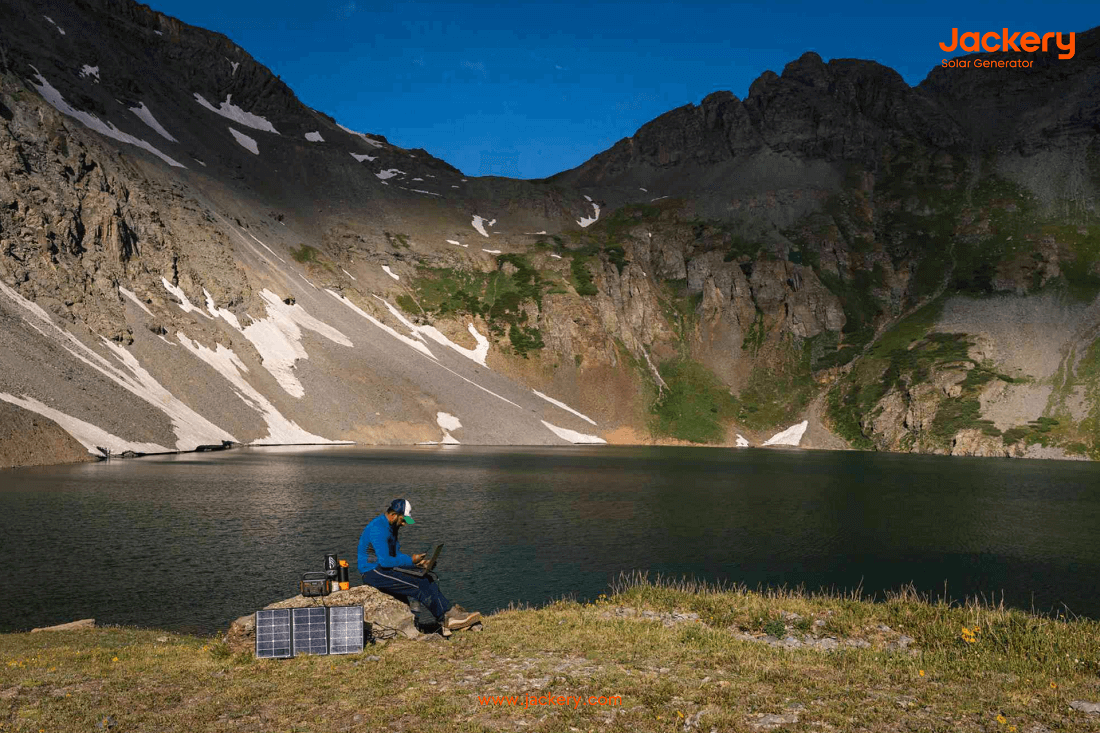
Repair Kit
A compact repair kit will assist you in repairing a tear in your backpack, a loose trekking pole, a broken strap, or any other unforeseen problems that may arise while you're out there.
While the contents of repair kits differ depending on the product, multipurpose equipment is always a good idea, such as a pocket knife, leatherman, repair patches, safety pins, or strips of the ever-useful duct tape.
Knives are helpful for gear repair, food preparation, first aid, kindling, and other emergency needs, making them an absolute must for every expedition. Every adult should carry knives in your group.
- Knife
- Repair Patches
- Safety Pins
- Duct Tape
Headlamp or Flashlight
The ability to move through the forest at night is crucial. So, always have some illumination on hand. Most wilderness travelers prefer a headlamp since it frees up your hands for other duties, such as cooking meals or gripping trekking poles.
If you get lost on the route after dark, you'll need a source of light to guide you back to the trailhead. Bring a tiny, lightweight flashlight for hands-free lighting if you don't have a headlamp. Check that the batteries are also charged.
Fire
You must have trustworthy resources for starting and sustaining a fire in an emergency. Many individuals prefer disposable butane lighters, but waterproof matches or containers for matches are also viable alternatives. Convenience shop matchbooks could be more flimsy and better built to be trusted for outdoor usage.
As the name implies, a firestarter is an element that aids in starting a fire and is essential in wet conditions. The ideal firestarter ignites fast and maintains heat for several seconds. Dry fuel in a plastic bag, candles, priming paste, and heat "nuggets" are all options.
First Aid
It is essential to have a first-aid kit on hand and know how to use its contents. Many people customize pre-assembled first aid kits to match their requirements, but they are a great time-saver for those who don't want to take any chances.
Investing in a portable and lightweight first aid kit that you can take in your bag alongside your hiking essentials is a good idea. While an emergency is unlikely, things like blisters, cramping, and minor cuts can happen, and it's always a good idea to be prepared.
Blister treatments, sticky bandages of various sizes, multiple gauze pads, adhesive tape, disinfectant ointment, over-the-counter pain medicine, pen and paper, and gloves should all be included in any pack.
Extra Food & Water
Your body requires water to function correctly. Bringing extra water, and even a water filter for extended walks in case you run out, is a must-have day hiking requirement while peak-bagging.
Staying hydrated in any weather can help you avoid dehydration or altitude sickness but also lets you feel good and have fun.
It's crucial always to have enough food on hand, but the goal of storing extra is genuinely for an emergency. It is preferable to bring a little more than you need. You'll also be expending more calories than usual, so don't skimp on snacks and nourishment.
Download Hiking Essentials Checklist PDF>>
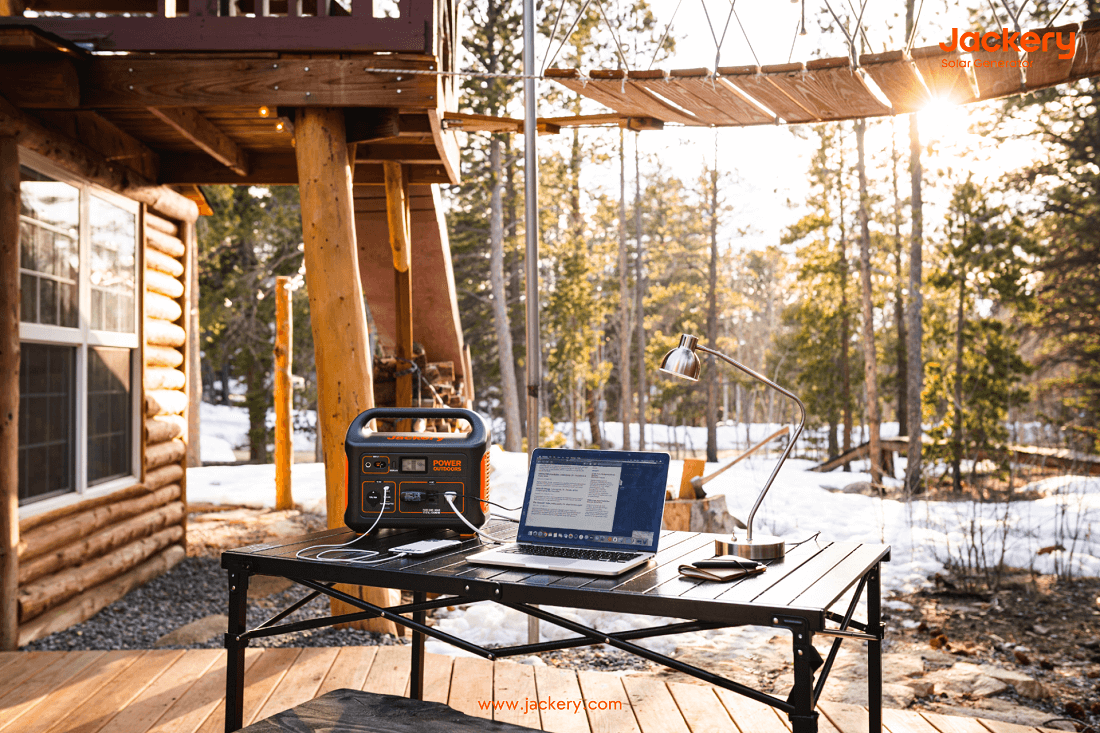
More Hiking Essentials
Hiking is a safe, pleasurable, inexpensive pastime if you know your needed equipment. The bare necessities include first aid supplies, sun protection, and navigation gear. This hiking essentials list, however, consists of some desired "extras."
Jackery Explorer Hiking Power Stations
A portable power station is a battery-powered inverter generator with an AC outlet, a DC carport, and USB charging power connections to your outdoor electronics, such as a mini cooler, coffee maker, CPAP machine, and more.
Jackery Explorer power stations are an incredible power source for your activities, whether camping, living off-grid, or needing a backup power supply. Compared to alternatives, it is up to 30% lighter and smaller.
It has an ergonomic handle design that makes it easy to carry anywhere you want to explore. Jackery offers portable power solutions ranging from 160W to 3000W and can power up to 99% of appliances.
Jackery is a well-known producer of high-quality solar equipment, such as solar panels, power stations, and solar generators. The Jackery Explorer portable power stations have intelligent BMS and advanced temperature sensors, elevating safety to new heights. They are quiet and efficient even at 14°F (-10°C).

The Jackery Explorer 300 portable power station has a power capacity of 293Wh and can power tiny electrical devices such as drones, mini-coolers, CPAP machines, etc. The upgraded multipurpose outputs, which include two pure sine wave AC outlets, a 60W type C PD connector, and a QC 3.0 port, let you power up to six intelligent devices simultaneously.
The Jackery Explorer 300 Portable power station can be charged in 3.5 hours (0-80%) utilizing SolarSaga 100W solar panels. For quicker charging, combine the wall outlet and the USB-C PD port. Car outlets and wall outlets are two other charging options.
|
Series |
Capacity |
Ports |
Recharge Time |
Hiking Appliances |
|
Jackery Explorer 300 |
293Wh |
1*60W PD USB-C 1* QC3.0 USB-A 1*Carport 2*AC Output |
1*SolarSaga 100W: 5H |
Light(5W): 46.9H GPS(50W): 4.7H Phone(29W): 8.1H Drone(60W): 3.9H Headphone(5W): 46.9H |
|
Wall Charging: 4.5H |
||||
|
Car Charging: 5H |
The Jackery Explorer 500 portable power station charges low to high-power appliances for extended periods. The power station is suitable for outdoor adventurers and emergency home backup solutions, with a high battery capacity of 518Wh, a foldable handle, an ergonomic design, and industry-leading BMS technology. With a weight of about 13.32 lbs, it is incredibly portable.
The Jackery Explorer 500 portable power station has 1 AC outlet, 2 DC ports, 3 USB-A connections, and one vehicle port for charging low to high-power appliances such as an air pump, CPAP machine, fan, flashlight, and more.
|
Series |
Capacity |
Ports |
Recharge Time |
Hiking Appliances |
|
Jackery Explorer 500 |
518Wh |
3*USB Outputs 1*AC Output 1*12V Carport 2*DC Output 1*DC Input |
1*SolarSaga 100W: 9.5H |
Light(5W): 82.9H GPS(50W): 8.3H Phone(29W): 14.3H Drone(60W): 6.9H Headphone(5W): 82.9H |
|
Wall Charging: 7.5H |
||||
|
Car Charging: 7.5H |
Day Hiking Essentials
A backpacking trip or a thru-hike are examples of multi-day hiking adventures, but a day hike is any outing on foot that can be finished in a single day. A day hike can range from a stroll through your neighborhood park to a 4-hour journey up your nearby mountain. Outside and enjoying nature for 2 or 12 hours has substantial mental and physical advantages.
However, a 2-hour trip and a 12-hour hike differ regarding preparation and equipment. The more clothing, gear, food, and water you'll need, the more extended and distant the trip, and the more adverse the weather. The following are the day hiking essentials:
- Hiking Daypack
- Clothing & Footwear
- Food & Water
- Navigation Tool
- First Aid Kit
Hiking with Dog Essentials
Allow your dog to transport their belongings with a specially made doggy backpack. These clever tiny backpacks, made of robust, lightweight, and dog-proof materials, can instantly transform your spoiled canine into a pack hound.
The two pannier pockets, which look more like a saddlebag than a backpack, are meant to distribute weight across your dog's back equally, and the adjustable harness is secured under your dog's chest and belly. The contents, made of weather-resistant nylon or polyester, will stay dry in mild rain, and some come with hydration bladders and additional gear loops and straps.
- Dog Backpack
- Dog Bowl
- Dog Food
- Dog Toy
Hiking Essentials FAQs
The following shows the frequently asked questions about hiking essentials:
- What size of power station do I need for my hiking?
A portable power station is considerably more critical for hiking because it allows you to charge your hiking equipment and is a backup power source for outdoor adventure. Jackery Explorer power stations are great for hiking due to their durability, mobility, and safety since they can power your gear, such as your phone, watch, GPS, and more.
Determine how much wattage you require for your fishing before selecting the appropriate size power station. Jackery power stations have capacities ranging from 3024Wh to 240Wh, and you can choose one according to your needs. Here's how to calculate how long it will take to charge your hiking essentials:
Working time = power station capacity*0.85 / your device's operating wattage
For example, using a Jackery Explorer 300 (293Wh capacity) to charge a 5W light will last 50 hours (293Wh*0.85/5W).
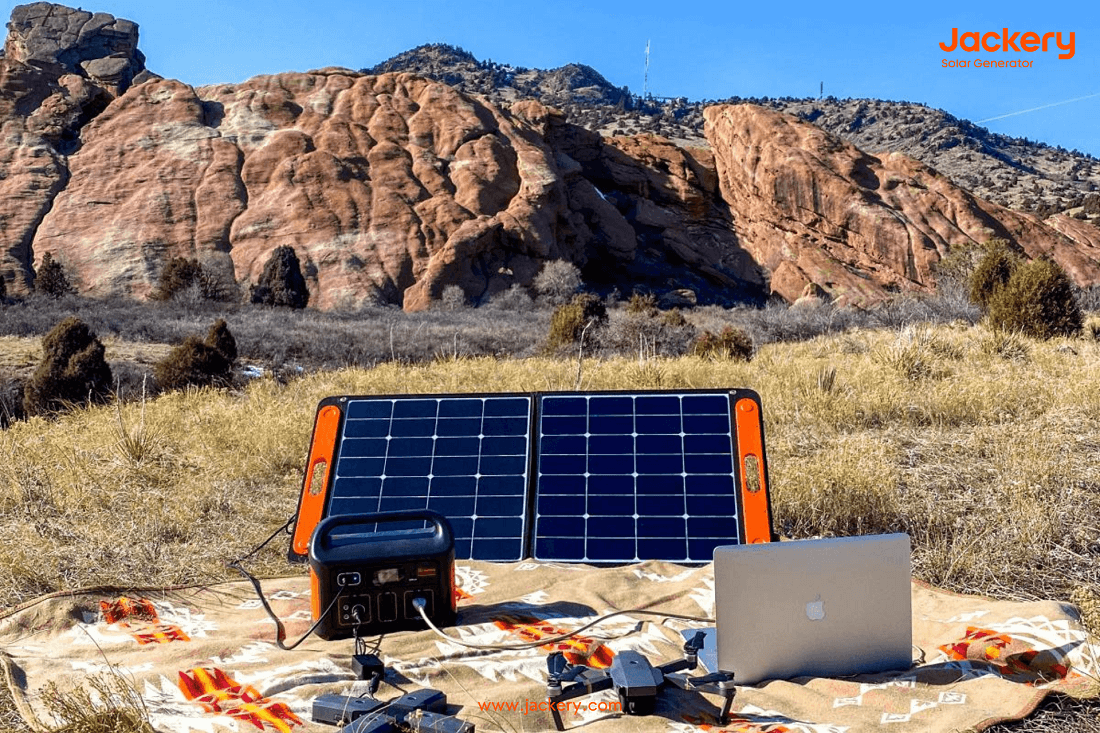
- What to consider when choosing hiking essentials?
Hiking benefits your body, mind, and soul, whether you love arduous excursions across rugged terrain or a relaxing wander across vast plains. Improve your outdoor fitness game with these great hiking basics to keep you warmer, move easier, eat better, stay safer, and even save your four-legged companion by your side.
- Know Your Needs: You must train to trek with a heavier pack than necessary. However, the ordinary day hiker must bring only some things on this list. Some are more suited to lengthy hikes, while others are only for pleasure!
- Weather Sensitive: Protect your sensitive goods when going over your hiking checklist and packing your luggage. You may keep paper goods like cash and toilet paper safe and valuable in these pouches. You want to protect your phone and camera on your day hike!
- Function over Fashion: Many outdoor businesses cater to function and fashion. However, the former is ultimately more vital for your experience and safety. Don't skip layers because they make you look heavy, and don't wear a shoe that is too tight just because you enjoy the look.
- What should you not pack in your hiking essentials?
It would be helpful if you did not go hiking or do anything else that might be considered a violation of the trail's rules. Take your pet into restricted locations, for example, or fly a drone in an area where it is illegal. Also, only bring something you're worried about losing or getting soiled on a trip!
Final Thoughts
Whether hiking to a beloved waterfall or summiting a challenging peak, having the right gear is essential. It could be the difference between a minor annoyance and a catastrophic outcome when things go awry, as they frequently do.
Dialing in hiking basics is vital to pre-trip preparations for first-timers and seasoned backcountry travelers. This specific hiking essentials guide will assist you in locating everything you require, including the top 10 essentials, hiking with dog essentials, and more. Including a Jackery Explorer power station on your list could also be suitable for charging your hiking electronics.
Disclaimer:
The runtime mentioned for appliances powered by Jackery is for reference only. Actual runtime may vary under different conditions. Please refer to real-world performance for accurate results.












































































































Leave a comment